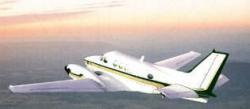Pilot Did Not Maintain Control In Instrument Conditions
 The NTSB has issued a probable
cause report in the February 1st, 2008 crash of a Raytheon C90A
King Air in which six people were fatally injured. The board
determined that the probable cause(s) of the accident to be the
pilot's failure to maintain control of the airplane in instrument
meteorological conditions. Contributing to the accident were the
pilot's improper decision to descend below the minimum descent
altitude, and failure to follow the published missed approach
procedure.
The NTSB has issued a probable
cause report in the February 1st, 2008 crash of a Raytheon C90A
King Air in which six people were fatally injured. The board
determined that the probable cause(s) of the accident to be the
pilot's failure to maintain control of the airplane in instrument
meteorological conditions. Contributing to the accident were the
pilot's improper decision to descend below the minimum descent
altitude, and failure to follow the published missed approach
procedure.
NTSB Identification: NYC08MA090
14 CFR Part 91: General Aviation
Accident occurred Friday, February 01, 2008 in Mount Airy, NC
Probable Cause Approval Date: 4/22/2010
Aircraft: RAYTHEON AIRCRAFT COMPANY C90A, registration: N57WR
Injuries: 6 Fatal.
While flying a nonprecision approach, the pilot deliberately
descended below the minimum descent altitude (MDA) and attempted to
execute a circle to land below the published circling minimums
instead of executing the published missed approach procedure.
During the circle to land, visual contact with the airport
environment was lost and engine power was never increased after the
airplane had leveled off. The airplane decelerated and entered an
aerodynamic stall, followed by an uncontrolled descent which
continued until ground impact.
Weather at the time consisted of rain, with ceilings ranging
from 300 to 600 feet, and visibility remaining relatively constant
at 2.5 miles in fog. Review of the cockpit voice recorder (CVR)
audio revealed that the pilot had displayed some non professional
behavior prior to initiating the approach. Also contained on the
CVR were comments by the pilot indicating he planned to descend
below the MDA prior to acquiring the airport visually, and would
have to execute a circling approach. Moments after stating a
circling approach would be needed, the pilot received a sink rate
aural warning from the enhanced ground proximity warning system
(EGPWS). After several seconds, a series of stall warnings was
recorded prior to the airplane impacting terrain.

King Air C90 File Photo
EGPWS data revealed, the airplane had decelerated approximately
75 knots in the last 20 seconds of the flight. Examination of the
wreckage did not reveal any preimpact failures or malfunctions with
the airplane or any of its systems.
Toxicology testing detected sertraline in the pilot’s
kidney and liver. Sertraline is a prescription antidepressant
medication used for anxiety, obsessive-compulsive disorder, panic
disorder, posttraumatic stress disorder, and social phobia. The
pilot’s personal medical records indicated that he had been
treated previously with two other antidepressant medications for
“anxiety and depression” and a history of
“impatience” and “compulsiveness.” The
records also documented a diagnosis of diabetes without any
indication of medications for the condition, and further noted
three episodes of kidney stones, most recently experiencing
“severe and profound discomfort” from a kidney stone
while flying in 2005. None of these conditions or medications had
been noted by the pilot on prior applications for an airman medical
certificate. It is not clear whether any of the pilot’s
medical conditions could account for his behavior or may have
contributed to the accident.
 Bolen Gives Congress a Rare Thumbs-Up
Bolen Gives Congress a Rare Thumbs-Up The SportPlane Resource Guide RETURNS!!!!
The SportPlane Resource Guide RETURNS!!!! Buying Sprees Continue: Textron eAviation Takes On Amazilia Aerospace
Buying Sprees Continue: Textron eAviation Takes On Amazilia Aerospace Hawker 4000 Bizjets Gain Nav System, Data Link STC
Hawker 4000 Bizjets Gain Nav System, Data Link STC Echodyne Gets BVLOS Waiver for AiRanger Aircraft
Echodyne Gets BVLOS Waiver for AiRanger Aircraft




